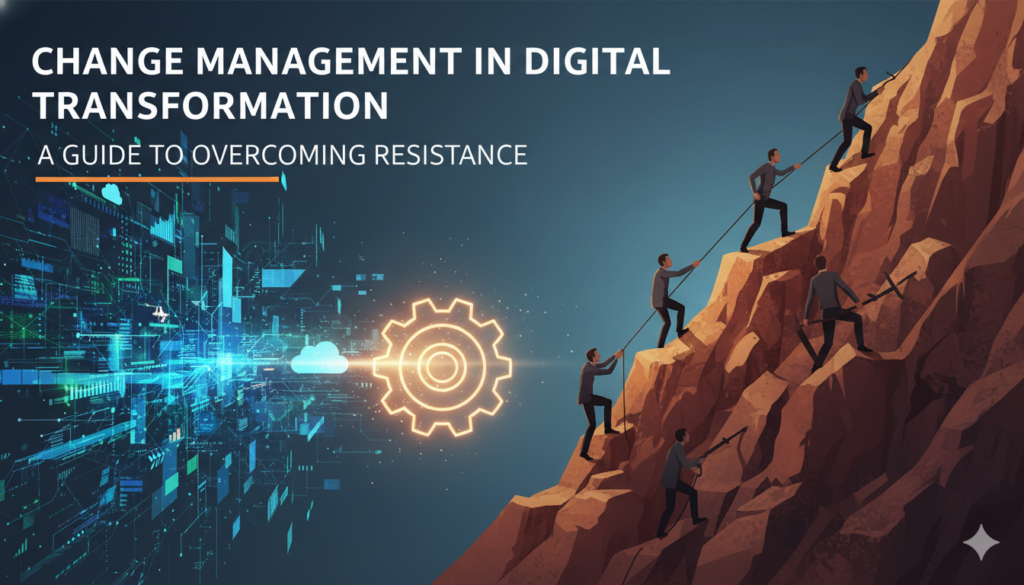Digital transformation isn’t just a technology upgrade – it’s a strategic shift. Yet despite investing millions in cloud migrations, automation tools, customer experience platforms, and data initiatives, many organizations still struggle to answer one simple question: What are we getting in return?
Boards want more than updates on app rollouts or system integrations. They want to understand how digital initiatives are increasing revenue, reducing operational friction, or creating competitive advantage.
The challenge? Traditional ROI models weren’t built for complex, multi-layered transformations. They miss the nuance of cross-functional impact, long-term value, and behavioral change.
In this blog, we’ll explore how to rethink ROI in the context of digital transformation – and which metrics truly matter to the C-suite. From CFOs to CMOs, we’ll map KPIs to business outcomes, helping you measure what matters and justify every digital dollar spent.
1. Why Traditional ROI Models Fall Short in Digital Transformation
When evaluating digital transformation efforts, many organizations default to the same playbook they use for IT projects: track spend, look for cost savings, and measure delivery speed. But digital transformation is not a linear investment – it’s an ecosystem shift.
Here’s where traditional ROI thinking falls short:
1.1 Narrow Focus on Cost Reduction
ROI models often prioritize tangible, short-term gains – like reduced headcount or IT spend. But digital transformation frequently unlocks value through growth, agility, and experience – less immediate, but far more strategic.
1.2 Output ≠ Impact
Teams may report the number of workflows automated or cloud apps launched, but those don’t guarantee meaningful outcomes. Without linking to metrics like reduced cycle times, improved margins, or customer retention, it’s hard to prove value.
1.3 Value is Distributed, Not Isolated
Digital programs often span departments – marketing, operations, HR, finance. Traditional models try to isolate impact, but transformation is inherently cross-functional. Measuring ROI in silos creates blind spots.
1.4 Vanity Metrics Distract from What Matters
Metrics like “app logins” or “pageviews” may look good in reports but say little about business performance. The C-suite needs insight into business levers – not surface-level data points.
To move forward, organizations need a smarter approach: one that connects digital investments to business outcomes executives care about – growth, efficiency, experience, and resilience.
Reframing ROI – From Outputs to Outcomes
One of the biggest shifts in maximizing digital transformation ROI is moving from outputs to outcomes. It’s not about what gets built – it’s about what changes as a result.
Too often, teams showcase dashboards full of activity metrics: systems deployed, users onboarded, features released. But the C-suite is asking a different question: What’s the business impact?
Here’s how to think about the difference:
| Output | Outcome |
| Deployed a new self-service portal | Reduced support ticket volume by 30% |
| Migrated legacy systems to the cloud | Improved time-to-market for new features by 25% |
| Trained 200 employees on new tools | Increased digital adoption rate to 80% within 90 days |
| Automated a sales workflow | Cut lead response time from 3 days to 4 hours |
The transformation itself isn’t the ROI. It’s what the transformation enables – faster delivery, better margins, happier customers, and empowered employees.
To reframe ROI properly:
- Tie initiatives to enterprise-level goals: revenue growth, operational efficiency, risk reduction, customer retention.
- Involve business unit leaders early to define expected outcomes.
- Prioritize lead indicators (e.g., adoption rate, cycle time) alongside lag indicators (e.g., revenue impact).
This shift ensures that digital transformation moves out of the IT lane – and into the core of strategic business conversations.
The Metrics That Matter – C-Suite Breakdown
Different leaders care about different outcomes. To maximize buy-in and accountability, digital transformation metrics must align with the unique priorities of each C-suite role.
Below is a breakdown of what matters most to key decision-makers – and how to report ROI in a way that resonates.
CEO / Founder: Strategic Growth & Market Positioning
The CEO is focused on long-term value creation and competitive differentiation.
Metrics that matter:
- Digital revenue contribution: % of revenue from digital channels, products, or services
- Customer Lifetime Value (CLTV) uplift post-digital adoption
- Speed to market: Reduction in time taken to launch new features/products
- Innovation index: Number of initiatives tied to new business models or capabilities
Narrative tip: Link metrics directly to strategy – market expansion, innovation, customer satisfaction, and brand equity.
CFO: Financial Efficiency & Return on Investment
The CFO needs to see hard returns, risk mitigation, and efficiency gains.
Metrics that matter:
- Cost savings through automation or process optimization
- IT spend ROI: Value delivered per dollar invested in tech
- Operating margin improvement post-transformation
- Total Cost of Ownership (TCO) for new platforms vs legacy systems
Narrative tip: Show how digital reduces cost and improves financial agility – forecasting accuracy, resource allocation, etc.
CIO / CTO: Time-to-Value & Platform Effectiveness
The CIO/CTO drives execution and needs clarity on adoption, scale, and stability.
Metrics that matter:
- Time-to-value: How quickly new systems deliver measurable outcomes
- Platform adoption rate across teams
- Uptime & system reliability improvements
- Tech debt reduction or consolidation savings
Narrative tip: Emphasize stability, usability, and ability to support future growth – not just delivery timelines.
CMO: Pipeline Quality & Experience Impact
The CMO wants digital to drive smarter marketing and deeper customer engagement.
Metrics that matter:
- Lead-to-opportunity conversion rate
- Campaign ROI after digital tools are deployed (e.g., automation, segmentation)
- Customer engagement score post-digital personalization
- Attribution accuracy across channels
Narrative tip: Focus on how digital accelerates revenue generation, improves attribution, and boosts customer retention.
COO / CHRO: Productivity & Workforce Alignment
The COO and CHRO are interested in internal adoption, employee enablement, and operational fluidity.
Metrics that matter:
- Process cycle time reduction (e.g., order-to-cash, onboarding)
- Digital adoption rate across business units
- Employee engagement with digital platforms
- FTE hours saved via automation or self-service systems
Narrative tip: Quantify how transformation improves efficiency and reduces operational drag – without overburdening teams.
By tailoring metrics to C-suite priorities, you make ROI real, relevant, and resonant – ensuring digital transformation gets the executive support it needs.
How to Align Metrics with Strategic Business Goals
Choosing the right metrics is only half the battle. To truly maximize digital transformation ROI, those metrics need to align with business strategy, not just technical outputs. That means bridging the gap between IT execution and board-level outcomes.
Here’s how to get that alignment right:
1. Map Metrics to Strategic OKRs
Start with your company’s high-level objectives (revenue growth, customer satisfaction, margin expansion, market entry). Then reverse-engineer metrics that tie directly to those goals.
Example:
If your OKR is “Expand market share by 10%,” relevant transformation metrics might include:
- Time to launch localized products
- Digital adoption in new geographies
- Growth in self-service or digital touchpoints
Avoid standalone tech KPIs like “# of APIs built” unless they clearly contribute to the business outcome.
2. Co-Create KPIs with Business Stakeholders
Don’t let the tech team define metrics in isolation. Collaborate with functional leaders (sales, finance, ops, product) to define what success looks like in their world – and how digital can get them there.
This cross-functional alignment ensures:
- Ownership across departments
- Relevance in reporting
- A unified story when presenting to the board
3. Use a Blended Scorecard Approach
Track three types of metrics together:
- Business Value Metrics – revenue lift, margin gain, retention
- Operational Efficiency Metrics – automation impact, process speed
- User Adoption Metrics – usage rate, training completion, feedback scores
This blended view shows not just what’s been delivered, but also what it’s enabling.
4. Balance Leading and Lagging Indicators
Lagging metrics like ROI or cost savings matter – but they arrive late. Balance them with leading indicators that signal progress early, such as:
- % of users trained within 30 days
- Automation coverage of manual tasks
- Cycle time reduction in pilot processes
Leading indicators help you adapt in-flight – before outcomes stall or regress.
Common Pitfalls in Measuring Digital ROI (and How to Fix Them)
Digital transformation often fails – not because the technology didn’t work, but because success wasn’t measured meaningfully. Here are the most common ROI missteps and how to avoid them:
Pitfall #1: Measuring Activity Instead of Impact
Teams often report on what they did – not what changed.
- “We deployed the new CRM.”
- “We trained 300 users.”
But the C-suite wants to know: What business outcome did it drive?
Fix: Translate outputs into business value. Focus on reduced cycle times, improved conversion rates, or cost savings – not just feature releases.
Pitfall #2: Relying Too Heavily on Lagging Indicators
Revenue and cost savings take time to materialize. Waiting for lagging metrics can delay decision-making – or worse, make it too late to course-correct.
Fix: Track leading indicators alongside lagging ones. For example:
- % of team adoption within 30 days
- Drop in manual intervention
- Time-to-complete key processes
Pitfall #3: Tracking Metrics in Silos
Marketing tracks engagement. Sales tracks pipeline. Ops tracks efficiency. But no one connects the dots.
Fix: Create a unified dashboard or scorecard across departments. Blend performance, adoption, and business value metrics into one narrative.
Pitfall #4: Prioritizing Vanity Metrics
Pageviews, app logins, and number of Slack messages sent may look good in a deck – but rarely influence business outcomes.
Fix: Audit your KPIs. If a metric doesn’t support a strategic decision or next step, it’s noise. Drop it or replace it.
Pitfall #5: Measuring Too Early (or Too Late)
Many transformations are judged prematurely – or far too late. You either celebrate adoption without value, or miss the window to prove ROI.
Fix: Establish a clear measurement timeline. Set checkpoints:
- 30-day: adoption
- 90-day: efficiency
- 6-month: value realization
Avoiding these pitfalls ensures that your transformation efforts are seen, understood, and valued by decision-makers.
Conclusion: Elevating the ROI Conversation
Digital transformation is no longer about adopting the latest tools – it’s about driving measurable business value. And that value can’t be captured through surface-level activity metrics or isolated success stories.
To maximize ROI, leaders must shift their mindset:
- From outputs to outcomes
- From lagging reports to leading indicators
- From department metrics to unified, executive-aligned scorecards
When transformation metrics reflect what the C-suite truly cares about – growth, efficiency, experience, and agility – it becomes easier to justify investment, drive alignment, and sustain momentum.
Ready to turn digital into business value?
At Qatalys, we help enterprises define, execute, and measure digital transformation programs that drive measurable outcomes. From workflow automation to cloud migration and CX innovation – we connect strategy to ROI.








